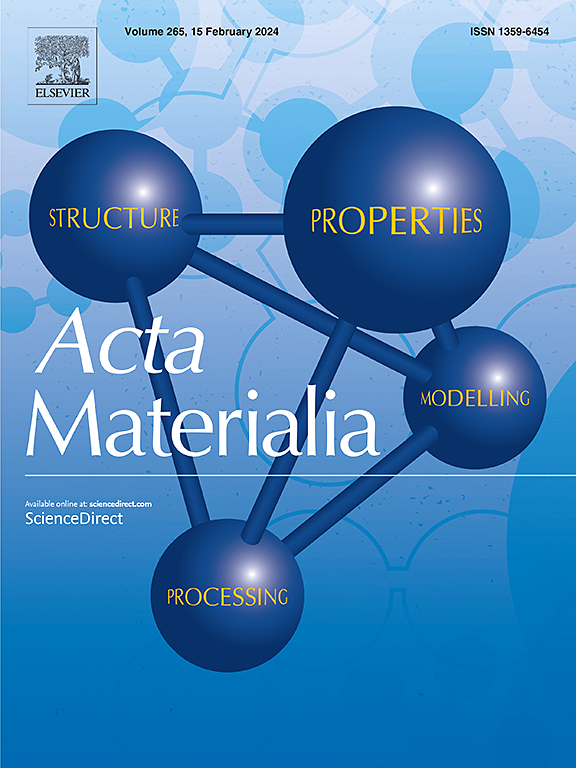TiCr2 Laves相吸氢的机器学习势
IF 9.3
1区 材料科学
Q1 MATERIALS SCIENCE, MULTIDISCIPLINARY
引用次数: 0
摘要
利用密度泛函理论(DFT)和机器学习原子间势(MLIPs)研究了0<;x≤6时C15立方相和C14六方Laves相吸氢的能量学。mlip使用一系列主动学习方案生成的配置进行训练。基于MLIPs的盆地跳跃蒙特卡罗(BHMC)模拟预测了最小能量氢构型,以及生成焓和氢的顺序。所得的相变与低温下的实验结果吻合较好。在0 K时,C15和C14相在低浓度α相中的氢溶解度极限分别为x=1.0和x=1.5。在这些浓度下,C15 TiCr2H表现为Cc单斜对称,而C14表现为Ama2正交对称,两者均未在该体系中报道。在0 K时,C15和C14的第一和第二氢化物相,即β和β′,分别出现在x=3和x=4附近。在二氢化物β′相中,C15 TiCr2H4表现为I41/a四方对称,而C14 TiCr2H4表现为R3 / c菱形对称。发现氢斥力扩展到共享边间隙,影响氢的有序。此外,在低氢浓度下,发现6h2 - A2B2间隙比其他A2B2间隙在能量上更有利于C14,从而影响了氢占据趋势。本文章由计算机程序翻译,如有差异,请以英文原文为准。


Machine learning potentials for hydrogen absorption in TiCr2 Laves phases
The energetics of hydrogen absorption in C15 cubic and C14 hexagonal TiCr2Hx Laves phases is investigated for 0 x 6 with density functional theory (DFT) and machine learning interatomic potentials (MLIPs). The MLIPs are trained with configurations generated through a series of active-learning schemes. Basin-hopping Monte Carlo (BHMC) simulations based on the MLIPs predict minimum-energy hydrogen configurations, along with enthalpies of formation and hydrogen orderings. The obtained phase transformations at 0 K agree well with the experiments at low temperatures. The hydrogen solubility limits in the low-concentration phases at 0 K are predicted to be x = 1.0 and x = 1.5 for the C15 and the C14 phases, respectively. At these concentrations, C15 TiCr2H shows the monoclinic symmetry, while C14 TiCr2H1.5 shows the orthorhombic symmetry, both of which have not been reported for this system. The first and the second hydride phases, i.e., and , at 0 K are found around x = 3 and x = 4, respectively, for both the C15 and the C14 phases. In the second-hydride phases, C15 TiCr2H4 shows the tetragonal symmetry, while C14 TiCr2H4 shows the rhombohedral symmetry. Hydrogen repulsions are found to extend to edge-sharing interstices, affecting the hydrogen ordering. Furthermore, the 6h2 A2B2 interstices are found to be energetically substantially more preferable for C14 TiCr2Hx than the other A2B2 interstices at low hydrogen concentrations, influencing the hydrogen-occupation trend.
求助全文
通过发布文献求助,成功后即可免费获取论文全文。
去求助
来源期刊

Acta Materialia
工程技术-材料科学:综合
CiteScore
16.10
自引率
8.50%
发文量
801
审稿时长
53 days
期刊介绍:
Acta Materialia serves as a platform for publishing full-length, original papers and commissioned overviews that contribute to a profound understanding of the correlation between the processing, structure, and properties of inorganic materials. The journal seeks papers with high impact potential or those that significantly propel the field forward. The scope includes the atomic and molecular arrangements, chemical and electronic structures, and microstructure of materials, focusing on their mechanical or functional behavior across all length scales, including nanostructures.
 求助内容:
求助内容: 应助结果提醒方式:
应助结果提醒方式:


